
Bishop John looks back on 60 years of priesthood
Page 5








Bishop John looks back on 60 years of priesthood
Page 5






Bishop Terry welcomes the election of Pope Leo XIV and says he looks forward to finding out more about him in the months and years ahead…
Despite all the predicting and prophesying, I think most people were genuinely surprised at the speed and the outcome of the recent conclave.
An American Pope! Against the present background of American civil and ecclesiastical politics, my imagination went wild.
Cardinal Robert Prevost OSA (Order of St Augustine); father of French descent and mother of Spanish origin.
He spent a good number of years working in South America, Peru to be exact, teaching and leading his order. He was only recently appointed a bishop and apostolic administrator to the Peruvian Diocese of Chiclayo, in 2014.
In early 2023 Pope Francis appointed him Prefect of the Dicastery for Bishops and created him a cardinal in September 2023. He takes the name of Leo XIV. But which Leo is he named after? Just to look at two – Pope St Leo the Great (Leo I), was appointed Pope in the fourth century, at the point where the West was in political and religious turmoil. He brought direction and unity to the western Church and society.
Pope Leo XIII was elected to the papacy in 1878 and died in 1903. Leo XIII is particularly remembered for his belief that the Church should be a vehicle of social justice, maintaining the rights and dignities of the human person.
In so many ways he was a great influence in what we now call Catholic Social Teaching, which plays such a major role in the Church’s interaction and intervention in the political and social life of the world.
So, which of these is he named after? Well, we will find out as his pontificate develops. One of his titles is “Supreme Pontiff”, which means the “Great Bridge-Builder” and in his first address from the balcony of St Peter’s, he said: “We are disciples of Christ. Christ goes before us, and the world needs his light. Humanity needs him like a bridge to reach God and his love. You, too, help us to build bridges with dialogue, with encounter, uniting us all so as to be one people always in peace. Thank you, Pope Francis!
“To all of you, brothers and sisters of Rome, of Italy, of all the world, we want to be a synodal Church, a Church on the move, a Church that always strives for peace, that always strives for charity, that always strives to be close, especially to those who suffer.”
Whatever we may be feeling at this moment concerning the election of our new Pope, it is absolutely incumbent on us to pray for Pope Leo XIV.
O God, who chose your servant Leo XIV in succession to the Apostle Peter as shepherd of the whole flock, look favourably on the supplications of your people and grant that, as
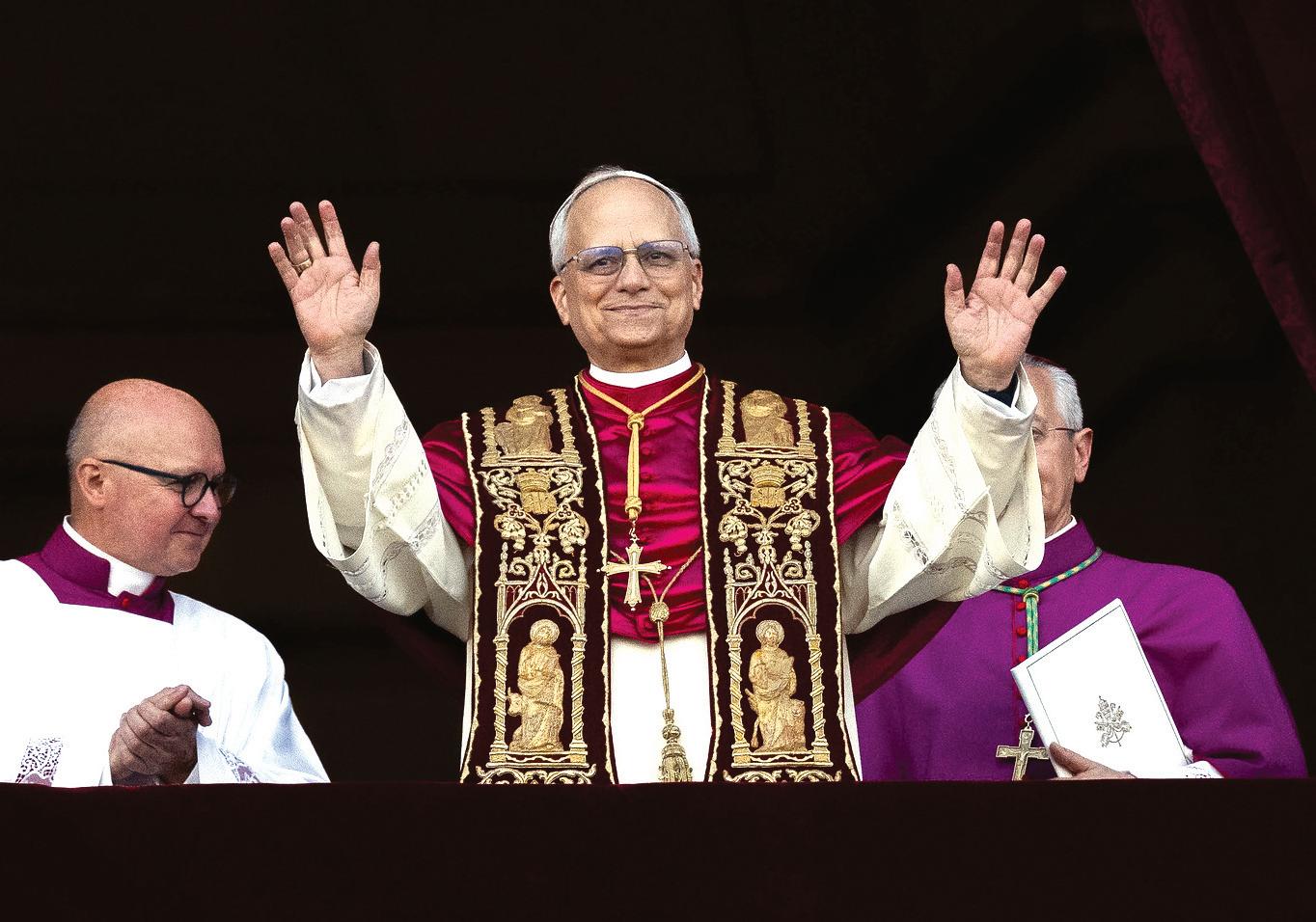
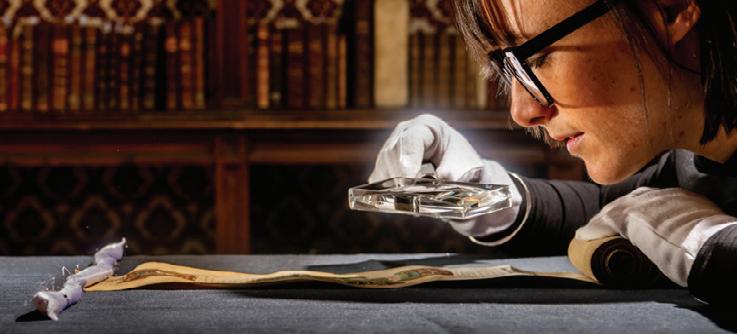


Just after 5pm UK time on Thursday May 8, white smoke billowed out of the temporary smokestack installed on the roof of the Sistine Chapel, heralding the news that a new Pope had been elected.
The identity of the man chosen as Supreme Pontiff to be spiritual leader of the Catholic Church would not be known for almost an hour.
The successful candidate had by then been asked, “Do you accept your canonical election as Supreme Pontiff?”
After giving his agreement he was asked what name he chose as Pope. Once both the agreement and choice of name were signed, Cardinal Robert Francis Prevost immediately became Bishop of Rome.
The cardinals held a brief ceremony with prayer, reading the scriptures and offering their congratulations. They then sang the Te Deum (Thee, O God, We Praise) and processed out of the chapel.
Before appearing on the balcony to be announced to the world, the new Pope stopped at the Pauline Chapel to pray in front of the Blessed Sacrament.
The announcement of a new Pope on the central loggia of St Peter’s, also known as the Loggia of the Blessings, was made by the protodeacon of the College of Cardinals, Cardinal Dominique Mamberti.
He told the vast crowd gathered and many millions more watching on TV throughout the world, “Annuntio vobis gaudium magnum: Habemus Papam” (I announce to you a great joy: We have a Pope!).
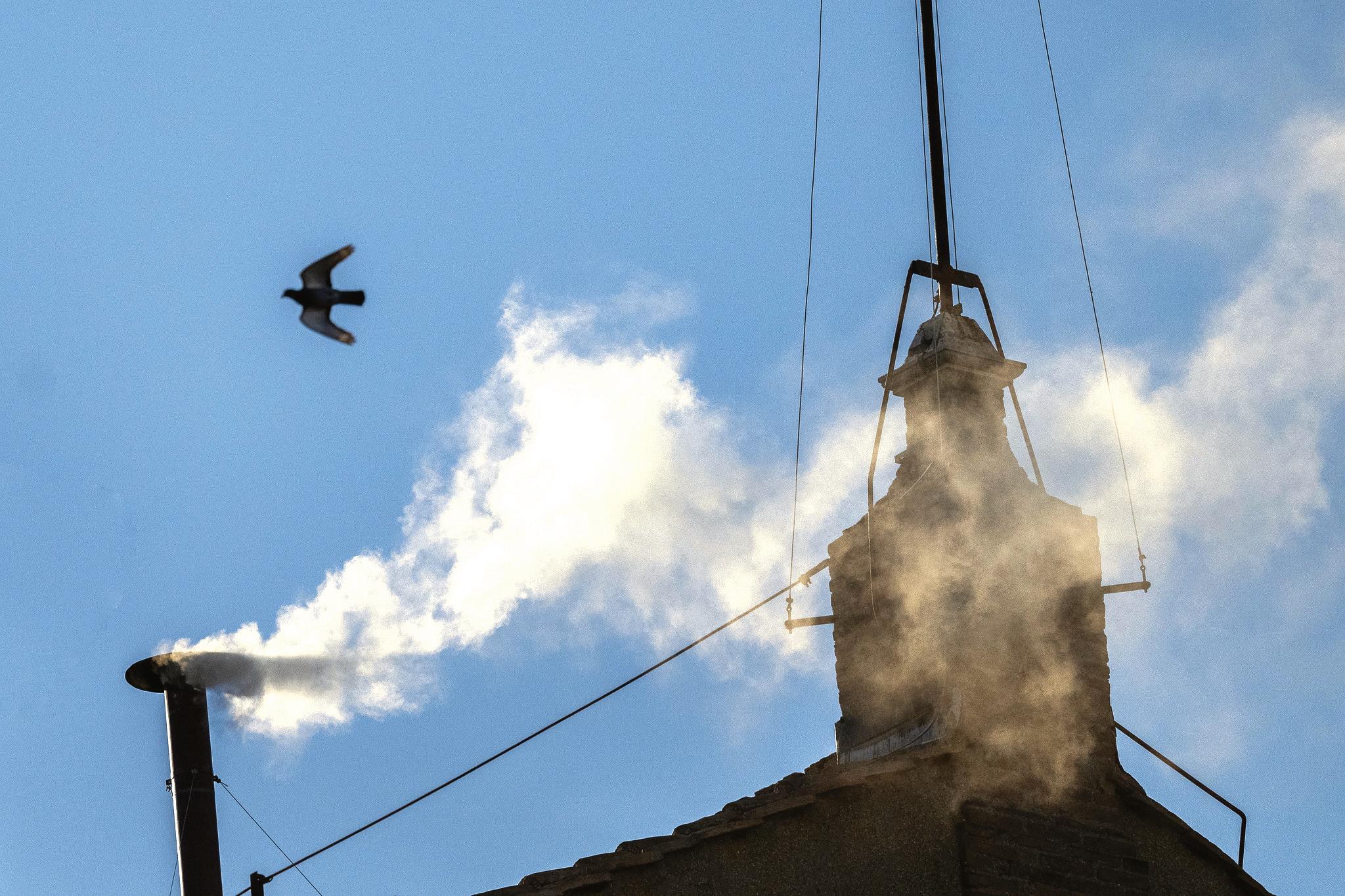
The first Augustinian Pope, Robert Prevost –now Leo XIV – is the second Roman Pontiff from the Americas after Pope Francis. However, unlike Jorge Mario Bergoglio, the 69year-old is from the northern part of the continent, although he spent many years as a missionary in Peru before being elected head of the Augustinians for two consecutive terms.
His episcopal motto is “In Illo uno unum” –words pronounced by St Augustine in a
1955: Born in Chicago, Illinois, on September 14 to Louis Marius Prevost, of French and Italian descent, and Mildred Martínez, of Spanish descent. He has two brothers, Louis Martín and John Joseph.
1977: Awarded degree in mathematics at Villanova University, Pennsylvania, after studying at the Minor Seminary of the Order of St Augustine (OSA). Enters the novitiate in the Augustinian province of Our Lady of Good Counsel, St Louis.
1981: Made his solemn vows and then studied for a diploma in theology at the Catholic Theological Union of Chicago.
1982: Studied canon law at the Pontifical St Thomas Aquinas University (Angelicum). Ordained priest on June 19 1982.
1984: Received his licentiate.
1985: Sent to the Chulucanas mission in Peru.
1987: Awarded doctorate for his thesis, “The role of the local prior in the Order of Saint Augustine”. Elected director of vocations and director of missions of the Augustinian province of Mother of Good Counsel in Illinois.
1988: Sent to the mission of Trujillo, Peru, as director of a joint formation project for Augustinians.
1989: Became judicial vicar of the Archdiocese of Trujillo and professor of canon, patristic and moral law in the San Carlos e San Marcelo major seminary.
1999: Elected prior of the Mother of Good Counsel Province, Chicago. After two and a half years, the ordinary general chapter elected him prior general of the order, a ministry again entrusted to him in the 2007 ordinary general chapter.
sermon on Psalm 127 to explain that “although we Christians are many, in the one Christ we are one”.
The first words of Pope Leo XIV after he was elected as the 267th Bishop of Rome were: “Peace be with all of you! A disarmed,
2013: Serves as teacher of the professed and provincial vicar in his home province.
2014: Pope Francis appointed him apostolic administrator of the Diocese of Chiclayo, Peru. Ordained bishop on December 12, Feast of Our Lady of Guadalupe.
2015: Appointed Bishop of Chiclayo.
2018: Becomes second vice president of the Peruvian Episcopal Conference.
2019: Pope Francis appointed him a member of the Congregation for the Clergy.
disarming, humble peace. God loves us all, unconditionally.”
He told the crowds gathered in St Peter’s Square: “Evil will not prevail.”
2020: The Holy Father appointed him apostolic administrator of the Diocese of Callao.
2023: Appointed prefect of the Dicastery for Bishops and president of the Pontifical Commission for Latin America. Proclaimed cardinal by Pope Francis in the Consistory of September 30.
2025: Elected Bishop of Rome.

Cardinal Vincent Nichols, one of 133 Cardinalelectors who took part in a Conclave that culminated in the proclamation of Cardinal Robert Francis Prevost as Pope Leo XIV, has spoken about the man who has succeeded Pope Francis as the 267th Supreme Pontiff. Describing Pope Leo XIV as a “citizen of the world,” Cardinal Nichols explained why his life experience and Catholic ministry provide the ingredients to lead the Catholic Church. He said: “He was brought up on the south side of Chicago – the poorer side. He has been the general superior of the Augustinians twice – which basically means he’s travelled the world twice – fulfilling those responsibilities.
“He’s been a teacher, a diocesan bishop and a member of the Roman Curia, and that’s a combination of talents that, once we’d reflected on the life of the Church and what was needed at this time, made it pretty clear that here was a man who was bringing the right depth and breadth of experience to the papacy.”
Speaking at a press conference at the Venerable English College in Rome, Cardinal Nichols elaborated further on the qualities of Pope Leo XIV: “He has a very gentle manner. He’s very calm. He’s clear in his mind and can be decisive.
“I’ve seen him resolve difficulties, both organisational and personal, in a way that didn’t leave enemies behind him, and he can hold people together. In terms of governance, he has a doctorate in canon law, so he knows how things should be done.”
Cardinal Nichols also reflected on the Conclave – a sacred time in the Sistine Chapel with his brother cardinal-electors acting at the service of humanity:
“I found it very refreshing, more like going on
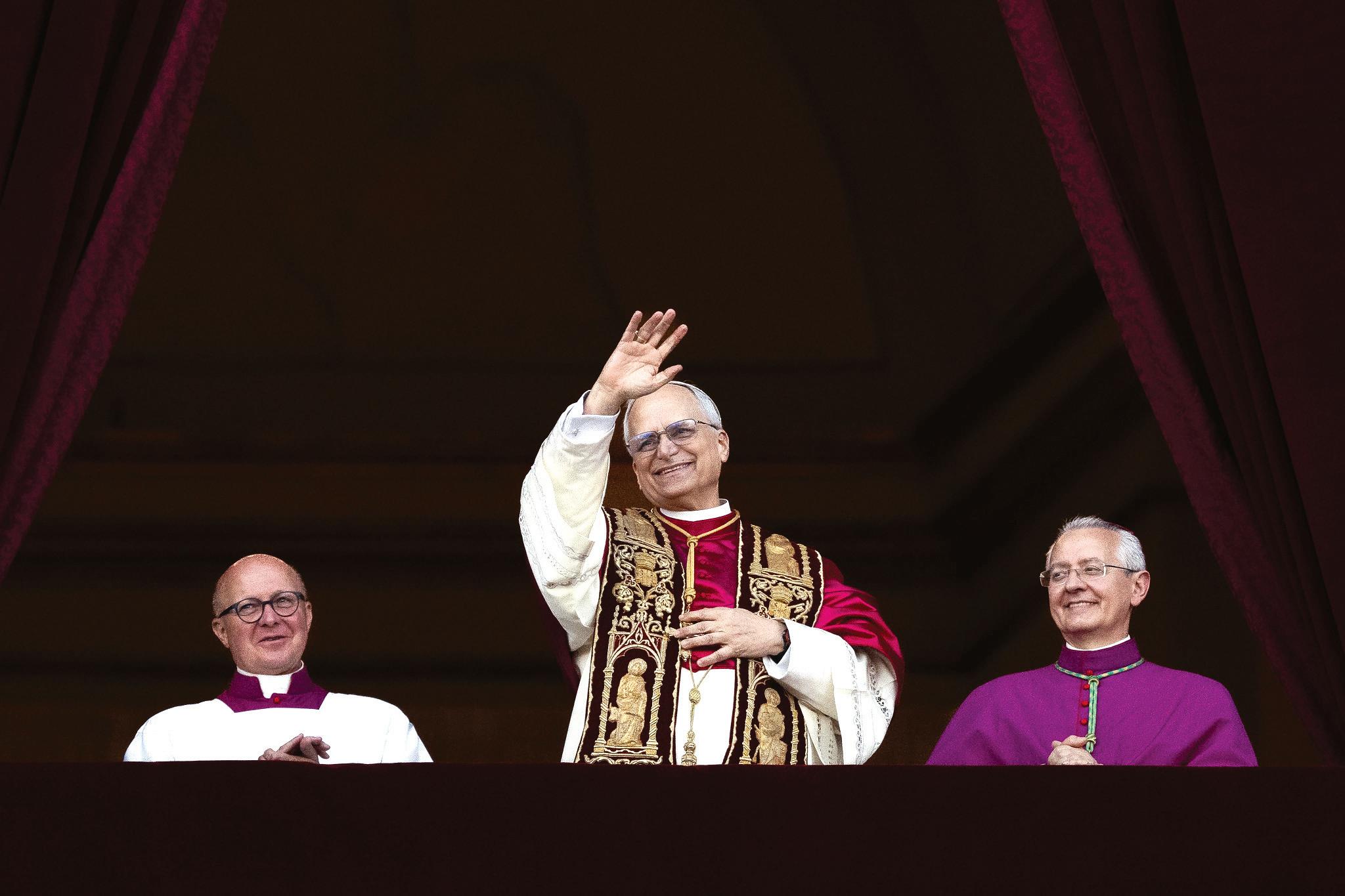
a spiritual retreat than anything else. There was a sense that here was a sacred space, and within that space, at a very profound level, it was possible to just be myself.
“By the time we were coming to lunch today, there was quite a bit of me that didn’t want to leave because there was something to be deeply treasured in the fraternity and the prayerfulness.
“I didn’t get a sense of people trying to gather in clusters or groups or any of that. This was a very, very lovely and congenial and fraternal time together.”
As I write, Leo XIV has been Pope for 24 hours. His chosen name, wardrobe and personal history have already been analysed. Speculation is rife about where he will decide to live and what he will establish as his priorities. Much of that will have been revealed by the time you read this.
Many have already signalled that choosing the name Leo nods to Pope Leo XIII, the author of Rerum Novarum and the importance of Catholic Social Teaching.
It does. The deposit of Catholic Social Teaching is good news, with much to offer a suffering world. Surely, it will figure significantly in Pope Leo’s pontificate, as it did in his immediate predecessors.
Falling into the temptation of viewing every
3 Attends the Ushaw College Trustees meeting via Zoom 11am Celebrates Confirmation Mass for the Southern Deanery at Sacred Heart Church, Hull 7pm
4 Celebrates Confirmation Mass for the Southern Deanery at Our Lady of Lourdes Church, Hessle 7pm
7 Celebrates Mass for the visitation of the Statue of Our Lady of Fatima at St Mary’s Cathedral, Middlesbrough 10.15am
10 Attends the Catholic Bishops of England and Wales Meeting via
choice he makes as a political statement is an easy mistake. However, we understand the significance of sign and symbol in our Catholic tradition, and if we can set aside the political, we will see the new Holy Father is prepared to embody the words he spoke to the world from the balcony of St Peter’s.
“We want to be a synodal Church, a Church that walks, a Church that always seeks peace, that always seeks charity, that always seeks to be close, especially to those who suffer.”
As he said several times, he is to be a bridge builder. So are we. But there is perhaps a little more. In his first Mass, celebrated with the cardinals, Pope Leo said there is an “indispensable commitment for all those in the Church who exercise a ministry of
Zoom 10am
Celebrates Confirmation Mass for the Coastal Deanery at St Paulinus Church, Guisborough 7pm
11 Celebrates Confirmation Mass for the Coastal Deanery at St Joseph's, Scarborough 7pm
12 Attends the Council of Priests meeting at the Curial Office, Middlesbrough 1.30pm
14 Celebrates the Diaconate Ordination Mass of four candidates at St Mary’s Cathedral, Middlesbrough Noon
15 Celebrates the Lourdes Thanksgiving
authority. It is to move aside so that Christ may remain, to make oneself small so that he may be known and glorified, to spend oneself to the utmost so that all may have the opportunity to know and love him.”
This may make us think of St Francis of Assisi, who gave up everything to follow Christ. He was born into a wealthy merchant family, living a carefree, privileged life.
However, after he experienced a spiritual awakening, he embraced a life of poverty, simplicity and service.
He believed in living like Christ, loving the poor, caring for the sick and honouring all creation as sacred. He was joyful, gentle, and had a deep connection with nature. St Francis preached with both words and actions.
Mass at St Mary’s Cathedral, Middlesbrough 10am
17 Attends a meeting of the Bishop’s Council via Zoom 10.30am Celebrates Confirmation Mass for the Northern Deanery at St Mary’s Cathedral, Middlesbrough 7pm
18 Attends the Jubilee Year Ecumenical Pilgrimage in York Noon
19 Celebrates Confirmation Mass for the Northern Deanery at Christ the King Church, Thornaby 7pm
20 Attends the Bishop’s Study Day in York 9am
But you may not know that St Francis had a confidante – Brother Leo! Brother Leo was St Francis’ best friend, secretary and confessor. They journeyed together, prayed together, and held each other in mutual respect. They knew each other “warts and all” and became especially close during the last years of St Francis’ life. Brother Leo is buried next to St Francis.
Of course, St Francis may remind us of Pope Francis, who lived simply and called the Church to embrace simplicity and service.
Pope Leo’s first words and actions echo that call by urging us to make ourselves small, so that only Christ may be seen.
Canon Paul Farrer
21 Attends Mass for the Platinum Jubilee of Ordination of the Very Reverend Canon Patrick Harney at English Martyrs Church, York Noon
22 Parish Visitation to St Vincent de Paul Church, Hull
24 Attends DTEC Meeting at the Curial Office, Middlesbrough 10.30am
29 Attends Mass for the Silver Jubilee of Ordination of Very Reverend Monsignor Canon Gerard Robinson, Vicar General, at St Joseph’s Church, Stokesley 10.30am
A North Yorkshire school with just 17 pupils has received the highest possible judgement in its latest Ofsted report.
Inspectors graded “unique and ambitious” St Hedda’s Catholic Primary School in Egton Bridge, which serves communities throughout the Esk Valley, as outstanding in all areas.
“Pupils thrive at this happy and welcoming rural school,” the glowing report says.
“Positive, caring relationships between pupils and adults mean pupils feel well cared for.
“Pupils’ behaviour is exceptional. They demonstrate kindness and respect towards each other. Pupils realise the school’s ESK values of ‘excellence, self-belief and knowledge’ in all aspects of their work and play.”
Inspectors praised the “incredibly rich and rewarding range of experiences and wider opportunities” pupils are given, including visits to the Houses of Parliament, Middlesbrough Football Club and a theatre trip to Newcastle.
And they said: “Leaders have worked effectively to develop a curriculum which is highly ambitious and implemented consistently well. This enables pupils to achieve highly in all subjects.
“Leaders are determined that pupils’ opportunities will not be limited by the size of the school. Leaders at all levels are passionate about realising pupils’ potential. They are exceptionally ambitious for the pupils and the community the school serves.
“Those responsible for governance ensure that the school’s work is making a difference to pupils’ learning and wellbeing. The school has benefited exceptionally well from support provided by the trust.”
Executive headteacher Kendra Sill said the



Christ the King Primary School
A member of Nicholas Postgate Catholic Academy Trust
Tedder Avenue, Thornaby, Stockton-On-Tees TS17 9JP
Executive Head Teacher: Mr M Ryan
Head of School: Miss H Lickess
Tel: 01642 765639
Email: enquiries@ctking.npcat.org.uk


outcome results from a team effort and thanked children, families, staff and governors.
“We couldn’t have achieved this wonderful recognition without the support of our parents who have put their trust in us over the last two years and remained committed to the school’s success,” she said. “We are so grateful to them all.
“This result reflects not only our focus on academic excellence but also the way we help the children develop their talents and interests.
“Our governors have seen the challenges we have faced over the last two years and have been there every step of the way to ensure we have grown as a school and community. Their commitment to St Hedda’s has been
unwavering.”
She also praised Nicholas Postgate Catholic Academy Trust (NPCAT), which runs St Hedda’s along with 37 other schools throughout Teesside and North Yorkshire.
She said: “Without NPCAT we could not have achieved what we have. The investment in buildings, IT, finance, the support from the primary standards team and NPCAT Sport has ensured continued growth.
“We are incredibly proud of what we have achieved together, but this is just the beginning. Although the report does not identify any areas for improvement, we will continue challenging ourselves to build on this success, ensuring our pupils thrive both academically and personally.”
NCPAT chief executive officer Hugh Hegarty said this success for the trust’s smallest school will be celebrated throughout the trust family.
He said: “To be judged outstanding in every category reflects the tireless commitment of our staff, the unwavering support of our families, and, most importantly, the dedication and talent of our pupils.
“This achievement reaffirms our trust’s mission to provide the highest standards of Catholic education, where academic excellence and faith formation go hand in hand.
“We draw inspiration from the legacy of Blessed Nicholas Postgate, a figure of unwavering faith and service, who walked the very paths of Egton Bridge.”

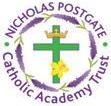
St Margaret Clitherow
Catholic Primary School
Part Of the Nicholas Postgate Catholic Academy Trust
South Bank, Middlesbrough TS6 6TA Tel 01642 835370
Headteacher: Miss C McNicholas
email: enquiries@smc.npcat.org.uk
If you would like to advertise your school
please contact Charlotte Rosbrooke on 01440 730399 or email charlotter@cathcom.org
Trinity Catholic College, Middlesbrough, student Sarah Ugwu won the Ambrose Griffiths Trophy at the Catenian Association Public Speaking Contest for her impressive speech on “Loneliness, the hidden epidemic”.
Sarah explained that loneliness affects people of all ages, from young people to older adults, and can be triggered by events such as loss.
She revealed that a staggering 73% of Generation Z suffer from loneliness and offered practical advice, encouraging volunteering and connection-building.
“The best way to get connected is to be the connection,” she said in her closing remarks.
The competition, held at Sacred Heart Catholic High School in Fenham, Newcastle, drew a record number of nine contestants in Sarah’s category alone, with 22 students from 11 Catholic schools across northern England taking part.
They ranged from Year 6 pupils to sixth-form students, all showing remarkable courage as they delivered speeches on a variety of topics.
The event was attended by an audience of around 80 people, including parents, peers,
teachers, headteachers, members of the Catenian Association, and competition organisers. The judging panel was Canon Paul Farrer, dean of St Mary’s Cathedral, Ian Calvert, director of Catenian Province 5 and
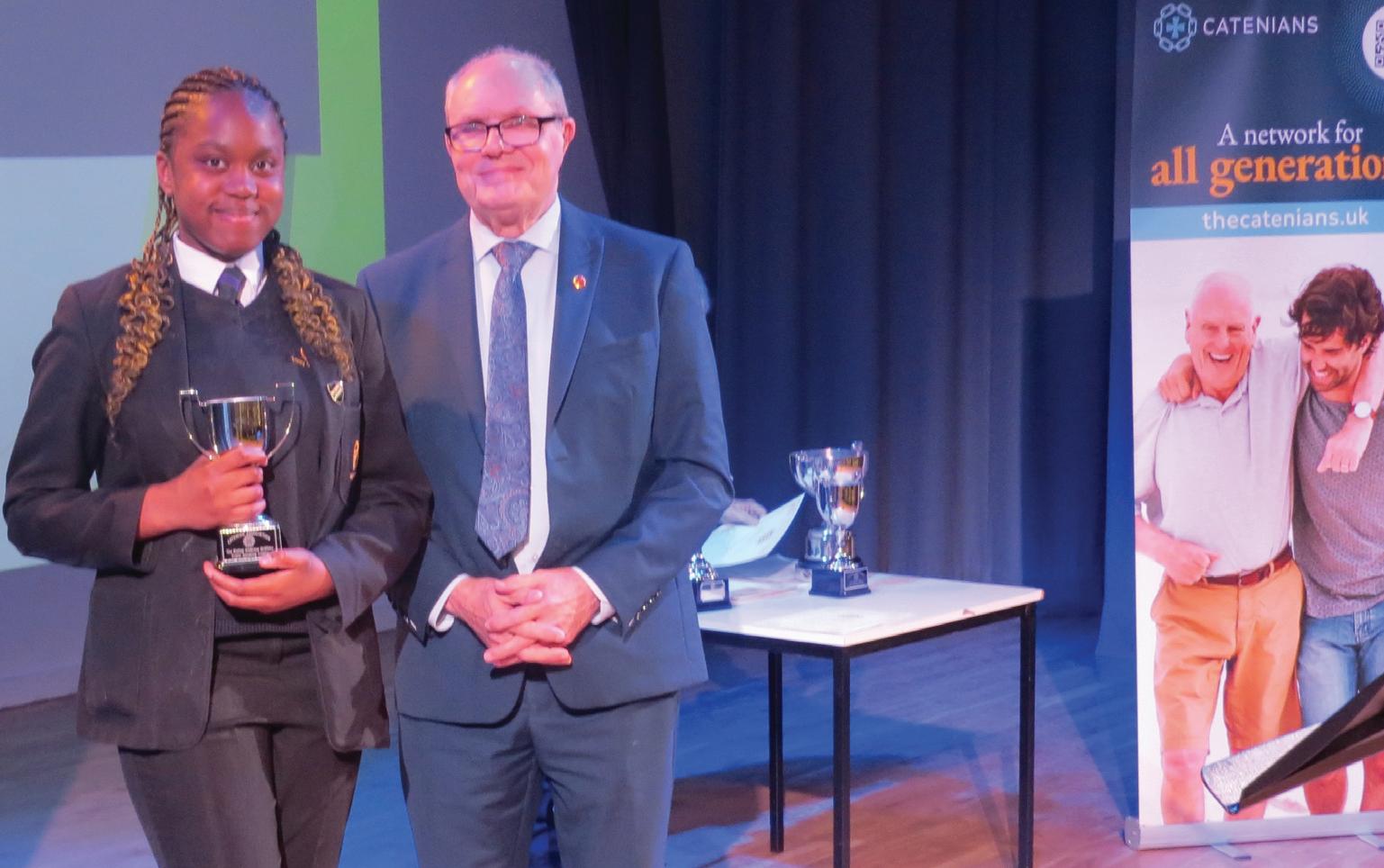
Dear friends in Christ, I am writing this little reflection on priesthood just a few weeks before celebrating my Diamond Jubilee on June 12.
On that night, I hope to offer a Mass of thanksgiving in the parish of St Agnes in north-west London, which has been my home for the past seven years.
Then, on Saturday July 26, I will have another chance to mark those 60 years of priesthood, this time in conjunction with Bishop Terry’s 50th anniversary at St Mary’s Cathedral in Middlesbrough.
When I look back to where it all started, in Holy Trinity Parish, Brook Green, West London, it was there in those first three years that I received a great grace which has nourished my life as a priest ever since.
That grace was mediated to me by the Little Sisters of Jesus, also known as the Sisters of Charles de Foucauld. At the centre of their daily life is a commitment to an hour of prayer, ideally in the presence of the Blessed Sacrament.
It was witnessing their fidelity to this prolonged period of prayer each day (and seeing the spiritual energy which flowed from it for their life of friendship and hospitality to all those they encountered), which encouraged me along the same path.
And down the years since then, that commitment to an hour of prayer each day, albeit at times faltering, has been such a gift of stillness amid all the busyness of pastoral activity.
Taking a leap of trust in the darkness of faith
But now let me bring my personal faith story up to date as the Diamond Jubilee approaches.
Some words of the late Pope Francis in his letter to the Church in 2018 on the theme of holiness, Gaudete et Exsultate (Rejoice and Be Glad), capture best what is my deepest desire for whatever years of life are left to me.
“God asks everything of us, and in return gives us everything; peace of mind and heart in the service of the Gospel.”
More and more strongly the realisation dawns that if we are willing, come what may, to place all our trust in God, then nothing can rob us of that peace and happiness which God alone can give.
The challenge, and it is a big one, is to make that leap of trust in the darkness of faith.
This “letting go” has to come first before the joy and peace can follow in its train.
And it is in that context that our memory, I find, plays such a crucial role, reminding us that God has remained utterly faithful to us amid all the twists and turns of everyday life.
“For I am convinced that neither death nor life, nor angels, nor rulers, nor things present, or things to come, nor powers, nor heights, nor depths, or anything else in all creation, will be able to separate us from the love of God in Christ Jesus, Our Lord.” – (Romans 8, 37-39 RSV).


St Vincent’s VC Academy in Hull has been awarded an ‘Outstanding’ rating across all areas in its recent Catholic Schools Inspectorate (CSI) inspection.
During their visit, inspectors highlighted the school’s exceptional partnership with their parish, noting that this relationship is mutually beneficial.
Active and caring parishioners serve as living witnesses to their spiritual calling, acting as inspirational role models for the pupils.
The report also commended the pupils for their “deep sense of reverence and engagement” during prayer experiences, which are enhanced through the skilful and imaginative use of music.
One parent expressed their appreciation, saying: “You can tell it’s a school that cares deeply about everyone who goes there. They say kindness is the key to all hearts, and I truly believe they instil that in my children.”
Headteacher Philippa Donnelly said the rating reflects the dedication of staff, pupils and the wider community to foster an environment where academic excellence in Catholic Education and personal development go hand in hand.
“We are overjoyed with the outcome,” she said. “It was wonderful to have the opportunity to celebrate and share St Vincent’s VC Academy with the inspection team.
“I am incredibly proud to be part of such a loving, hardworking and dedicated school community.”

The parish of St Vincent’s in Hull celebrated with stalwart Eric Brady who was awarded the Pope’s medal, the Benemerenti – little knowing the Holy Father would pass away the very next day.
Eric has worked for the church for more than 65 years, first in St Bede’s, Hull, and for 53 years at St Vincent’s, carrying out work from the parish council, website and newsletter
down to more mundane activities such as litter picking and keeping the church grounds tidy.
A modest man quietly working in the background but always missed when away on well-earned holidays or during a recent medical emergency. A worthy recipient.
Adrian Crummay
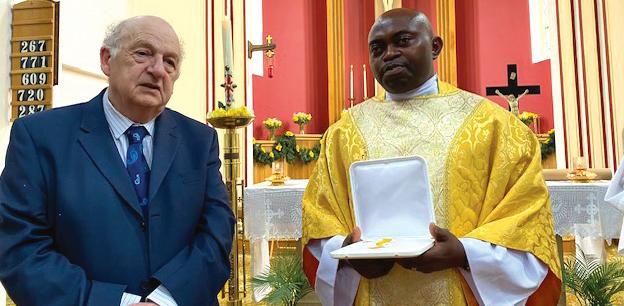
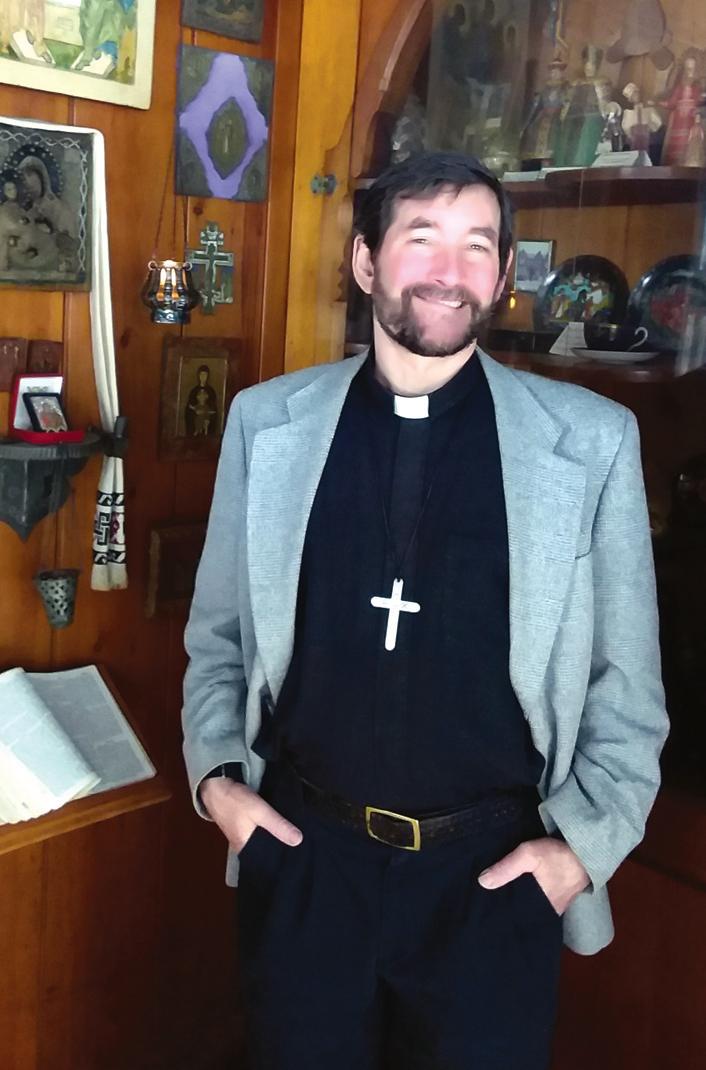
June is the month when we honour the Sacred Heart of Jesus. We would do well to explore the encyclical letter of Pope Francis on the Heart of Jesus.
Francis takes us on a very readable and profound journey into the history and the Devotion to the Heart of Jesus. Here is a very sketchy summary.
A picture of the heart of Christ is in the Christian imagination and spirituality from the very beginnings of our faith. Indeed, Pope Francis takes us back to early prophetic literature that implicitly speaks of God’s longing for broken humanity.
“Would a mother forget her child? …Yet, even so, I will not forget you” (Dilexit nos, 99).
In the gospels we hear the heart of Christ crying out for Jerusalem and calling all who are broken-hearted to come to him.
We see the heart of Christ consoling John at the Last Supper when the Beloved Disciple leans his head on the master’s breast. What intimacy! We see the precious Blood of Christ pouring forth from the heart of Jesus on the Cross. What divine liberality!
As the centuries progress, Christian writers expand on this opening of God’s heart to us.
St Ambrose: “Drink of Christ, for from his side flows forth living water” (Dilexit nos, 102).
St Augustine opens the way to devotion to the Sacred Heart as he sees “Christ’s wounded side not only the source of grace and the sacraments but also the symbol of our intimate union with Christ…” (Dilexit nos, 103).
In later centuries, St Bonaventure “takes up the symbolism of the pierced side of the Lord and understands it explicitly as a revelation and outpouring of all of the love of his heart” (Dilexit nos, 104).
The contemplative dimension of monastic life was fertile ground for going deeper into this mercy, especially among the women mystics, who began to speak of resting in the Heart of Christ and through his heart entering into mystical marriage.
We see that the ground had been well prepared for that time when the Lord eventually appeared to St Margaret Alacoque
to teach her the richness of devotion to his heart and ask her to promote it in the Church.
Pope Francis names many individuals who are part of this expansion of Christ’s gift of himself to us. Among others he mentions Blessed Claude de la Colombiere, Charles de Foucauld, Francis de Sales, Thérèse of Lisieux and John Paul ll.
The history and the unfolding of the Sacred Heart provide us with a great appreciation of how our faith is connected to history and history to our faith. It shows us how our spiritual lives are connected to so many people over the centuries and how each generation influences the next.
There is not a change in God’s love but a growth in our understanding and insights into his love. And yet each individual must make their own journey into the Heart of Christ. Can’t make a Jubilee pilgrimage to a place? How about into the Heart of Christ?
Father Kieran Kilcommons
St Richard’s Voluntary Catholic Academy in Hull has achieved an “Outstanding” rating in all areas after its latest Catholic Schools Inspectorate (CSI) inspection.
Inspectors said: “The mission of the school is exceptionally and authentically lived out by all and is the embodiment of the outstanding provision for the Catholic life of St Richard’s.”
They also highlighted the excellence in education practice, noting: “The quality of teaching, learning and assessment is outstanding.
“Teachers have a high level of subject expertise, confidence and authentic knowledge. They have a deep commitment to the teaching of Religious Education throughout the school.”
As one pupil said: “We are united with God as we are all his family.”
When pupils talked to inspectors about the prayer life of the school, one said: “Prayers are strong but not as powerful as acting upon it.”
Headteacher Emma Cook expressed her delight with the outcome.
“This report recognises the shared mission of every single member staff to enable our pupils to truly flourish spiritually, morally and academically.
“We are particularly proud of our wonderful pupils who shine so brightly every day and impressed the inspectors with their exemplary behaviour, compassionate acts, growing knowledge and deep reverence”.
Chair of the local governance board Michael Pickering added: “The report is a credit to the dedication of all the staff and aptitude of the children.”

The World Apostolate of Fatima in England and Wales (WAF) is arranging a weekend event at St Mary’s Cathedral as part of the celebrations for the centenary of the Fatima Five First Saturdays devotion.
The Pilgrim Virgin Statue and Relics of Saints Jacinta and Francisco will visit Middlesbrough on Saturday June 7 (10am to 4pm) and Sunday June 8 (from 10am).
In 2017, the National Pilgrim Virgin Statue and relics of the two saints visited churches throughout the country, including in Middlesbrough, Hull and York.
This latest event is a particular remembrance of the apparition to Sister Lucia, the oldest Fatima seer, which took place in December 1925 when she was a postulant with the Sisters of St Dorothy at Pontevedra, Spain. The Blessed Virgin appeared with the Child Jesus and gave more details of the devotion of reparation which she had mentioned to the shepherd children during the July 1917 apparition.
This devotion relates to the conversion of Russia and ultimately with world peace, which is why WAF is promoting it so strongly during the centenary year, with our world so much in need of peace.
It is also providential that this celebration coincidences with the larger celebration of the Church’s Jubilee Year, which has the theme of “Pilgrims of Hope”.
The weekend visitation will include events including:
• Procession of the Fatima Pilgrim Virgin Statue
• Enthronement and crowning of the Fatima statue
• Mass celebrated by Bishop Terry
• The opportunity to venerate the relics of St Jacinta and St Francisco
• Praying the Rosary for the intention of world peace
• During breaks, a book table will be available for browsing and purchases
• Talks and videos about Fatima
• Enrolment in the Brown Scapular devotion
• Holy Hour and Benediction
We need people to join our organisation to promote Fatima and the teachings of the Church. Visit worldfatima-englandwales.org.uk/ for more details.
Please make a note of the visitation and tell your friends and fellow parishioners about this important event. If you can help with the programme, please email membership@wafew.org.uk.
You can learn more details about the Five First Saturdays devotion at worldfatimaenglandwales.org.uk.
Donal Anthony Foley WAF England & Wales Committee

As we mourn Pope Francis and pray for the new Holy Father, we continue to celebrate the Jubilee Year, Pilgrims of Hope.
We recall that, in his letter for the Jubilee, Spes non confundit, Pope Francis invited us all to be “tangible signs of hope for those of our brothers and sisters who experience hardships of any kind”.
His model was the biblical Jubilee of the Book of Leviticus. Taking place every 50 years, the Jubilee marked a great societal reset – land was returned to its original owners, debts were cancelled, relationships restored and creation renewed (see Leviticus 25).
We celebrate this Jubilee Year in a world where injustice, conflict and abuse of creation are sadly still prevalent.
Just as the biblical Jubilee sought to transform economic and community life to reflect the values of God’s Kingdom, so we too are called to advocate for change today.
Central to this is the call for debt justice. In this Jubilee Year of Hope, Pope Francis called for richer countries to cancel the debts of poorer nations who are struggling with immense debt burdens, saying: “More than a question of generosity, this is a matter of justice.”
CAFOD is part of a worldwide Caritas campaign this year calling for action on the global debt crisis.
A petition being signed in 160 countries calls on world leaders to take urgent steps in this Jubilee Year. You can sign the petition at cafod.org.uk/debtpetition and also invite others in your parish to sign by ordering paper copies at cafod.org.uk/cancelthedebt.
As part of CAFOD’s parish materials there is a letter to parishioners in England and Wales from Father Charlie Chilufya, a priest based in Kenya.
Father Charlie explains the impact the debt crisis is having on the Kenyan people, since Kenya is spending five times as much on repaying foreign debts as it spends on hospitals and schools. “Families are foregoing medical care and children are losing access to quality education,” he says.
Pope Francis spoke about the debt crisis and the need for action in the Jubilee Year many times in the last months of his life.
Join parishes, schools and the whole Catholic community in responding to his call by visiting cafod.org.uk/cancelthedebt
We also celebrate Volunteers’ Week at the beginning of June, giving so much thanks to
act of charity.


our volunteers and all volunteers in the Church.
You all make such a difference and we couldn’t do what we do without you.
The St Hilda’s, Whitby, parishioner completed the CAFOD Big Lent Walk, a challenge that invites individuals or groups to trek 200 kilometres (about 125 miles, or three miles a day) over the 40 days of Lent.
They are asked to raise £200 for CAFOD’s overseas aid programme, but Bob, taking part for a third consecutive year, covered an impressive 442 kilometres (276 miles) and raising an astounding £770 – more than triple his target.
Bob regularly strides out with a local group, finding joy in the rugged beauty of the NorthEast coastline, and a walking holiday through the craggy Yorkshire Dales added extra miles to his daily routine.
But for Bob, the journey is more than physical – it’s spiritual. He views the walk as a fulfilling part of his Lenten obligations, a time for prayer and contemplation amid nature, complemented by almsgiving.
In past years, Bob’s efforts were supplemented by personal donations or contributions from his walking companions. This time, however, he cast a wider net, approaching his parish priest, Father Michael Sellars, with a request to feature his walk in the St Hilda’s newsletter.
Father Michael agreed, and the response was overwhelming. Of the £770 raised, an incredible £582 came from the generous parishioners of St Hilda’s, reflecting their shared commitment to CAFOD’s mission.
Bob would like to extend his heartfelt thanks to Father Sellars and the St Hilda’s community for their support.
He’s already looking ahead to lacing up his boots again for the Big Lent Walk in 2026.
Harry Baker
Thank you!
Canon Eddie Gubbins led a group from Scarborough and Middlesbrough to celebrate the 100th anniversary of the canonisation of St Thérèse of Lisieux by Pope Pius XI on May 17 1925.
Born Marie Françoise-Thérèse Martin on January 2 1873, Thérèse was the fifth surviving daughter of Louis Martin and Zelie Guérin, who were married in Alencon on July 13 1858. All five daughters became religious.
Both parents were devout Catholics who would eventually become the first and to date only married couple canonised together when Pope Francis made them saints in 2015.
Known as Sister Thérèse of the Child Jesus and the Holy Face, she described her spiritual pathway as the Little Way of the Little Flower.
Shortly before her painful death at the age of only 24 on September 30 1897, she said she thought her life’s work was only beginning.
Canon Gubbins celebrated Mass in the crypt of the Basilica of St Thérèse before a guided tour by Father Shane Lambert, a Carmelite priest from Canada.
This was followed by a visit to other places throughout the city including the Carmel of Lisieux, where her relics are kept and the Buissonnets family house where Thérèse grew up.
Back at the Ermitage of St Thérèse where the group were staying, no event with Canon Gubbins would be complete without a singalong.
In a quiet corner of the garden, with guitar in hand and the sun going down, the air wafted to the sound of Irish folk songs.
The following morning Mass was celebrated in the chapel in the garden of the Ermitage of St Thérèse before the group set out to spend the afternoon visiting the sites of Normandy.
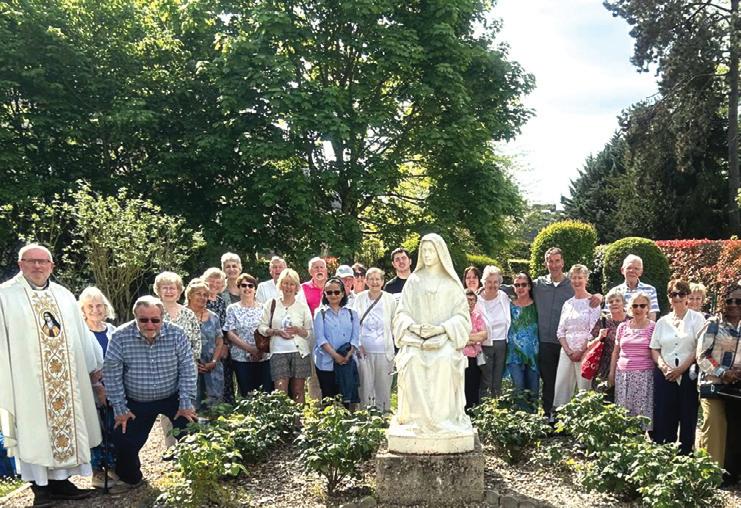
The first stop was Pegasus Bridge, the successful capture of which played such an important role in limiting the effectiveness of a German counterattack in the aftermath of the Normandy invasion.
There was also a visit to Gold Beach, where the British landed on D-Day and where the remains of the Mulberry Harbour can still be seen sticking out of the sea.
Finally, the group visited the war cemetery at Bayeux where more than 4,500 graves of the fallen lie.
A poignant moment occurred when a young Scottish ex-soldier stepped onto the monument and the sound of the bagpipes filled the air – a reminder of the sacrifice made by so many 80 years ago.
The group also visited the Chapel of the Rue du Bac on the way to Lisieux and could spend time in prayer at both the tomb of St Louise de Marillac and St Catherine Labouré.
On the way out of Paris there was just time to drive round the renovated Notre-Dame de Paris, the Champs-Élysées and the Arc de Triomphe.
Rory and Roland Connelly
The celebrations to mark the 80th anniversary of VE Day saw a 103-year-old great-great grandma sharing her experiences from the Second World War.
Jo Allan, from Linthorpe in Middlesbrough, was one of around 17,000 women employed at the ROF munitions factory in Aycliffe, County Durham.
They were known as “the Aycliffe Angels” after Nazi propagandist Lord Haw-Haw threatened: “Those little angels in Aycliffe will never get away with it.”
Jo, who was the Holy Name of Mary’s oldest parishioner before a recent move into a care home, would catch a bus and two trains on her daily journey from Middlesbrough to Heighington Station, near Aycliffe.
Sharing her memories, she said: “My job was to examine the bullets that had been made at Aycliffe, checking them for faults.
“We wore chamois leather gloves and had to roll a handful of bullets up and down on our hands, looking for defects. It was boring work but it was our part in the war effort.
“The supervisors would remind us that any mistakes could lead to the death of one of our soldiers.”
On her 100th birthday, the then Mayor of Middlesbrough Andy Preston presented Jo with a medal and certificate in recognition of her work as an Aycliffe Angel.

Allan played a vital role in the fight against the Nazis
And when her son Dave helped organise the Aycliffe Business Park Awards on the night of VE Day, nearly 300 businesspeople raised a glass in tribute to Jo and her fellow Aycliffe Angels.
Jo’s late husband David served in the RAF during the war as a wireless operator/gunner on Lancaster bomber aircraft. She was born on 18 November 1921 when George V was king.
Jo has 12 children, 37 grandchildren, more than 50 great-grandchildren and two great-great grandchildren, so more than 100 direct descendants!
She recently moved into MHA care home Montpellier Manor in the village of Stainton, part of the St Mary’s Cathedral Parish.
In the second of two features marking the 80th anniversary of Victory in Europe (VE) Day, John Hinman looks at aspects of the war from a German perspective…
Some 12 kilometres east of the Brandenburg Gate lies the district of Karlshorst, an area used extensively by senior Soviet military until reunification.
There the ratification ceremony of final surrender of German armed forces took place, ending the war in Europe at midnight on May 8 1945.
On May 2, all fighting had ceased on the southern front in Italy, where a surrender document had been signed three days earlier.
On May 4, a similar surrender was signed by representatives of the German forces in northwest Europe at Montgomery’s headquarters on Luneburg Heath.
On May 7, a further surrender document covering all German forces was signed at Eisenhower’s headquarters in Reims, a larger ceremonial finish carried out in the presence of Soviet, American, British and French representatives.
Despite all these arrangements, Stalin insisted on ratification taking place in Berlin on May 8 and the German military delegation was flown to Berlin for this purpose. Soviet defence minister Georgy Zhukov was master of ceremonies.
I first visited the then divided city of Berlin in July 1976 as a guest of a friend and his wife and their two small children.
James was one of the youngest majors in the army and his three-year posting was one of special duties.
I made several visits during his time in Berlin

as a guest of the British army, which provided not only security but access to the four sectors of the divided city.
James is an effective networker. He arranged for me to meet survivors from the sixth army, captured in Stalingrad in February 1943 and released from Soviet prisons in 1955.
He also arranged for me to make several trips on the last sealed military train in the world, travelling between West Berlin and West Germany, Soviet soldiers guarding British soldiers guarding British military and guests, as it crossed East Germany.
James charmed Soviet officers and enabled me to watch original newsreels in the Karlshorst building, in the company of senior Soviet officers who had served during what they call the Great Patriotic War and were visiting from Moscow. I was blinded by the gold braid and rows of medals.
During countless trips to the divided city and more since reunification I have been able to chart the remarkable progress made.
I have often been in Berlin for the July 20 commemoration of the failed plot to overthrow Hitler and other leading Nazis.
The families of those who opposed the regime attend every year. I have talked to the sons, daughters and other family members of Claus Von Stauffenberg and other key resistance figures.
It is a solemn state occasion with hymns and readings and the German president and the chancellor in attendance.
I have made many requests to the German Interior Ministry for family and friends to receive official invitations to the commemoration and I have always been well
looked after.
The speeches have always included a strong moral and religious theme.
This moving state ceremony is held in the courtyard of the Old Home Army, where most of the conspirators were based.
The Home Army building also charts all forms of resistance to the regime. Of particular interest is the number of rooms given over to resistance from Church and faith groups.
Details of Catholic resistance is only one aspect of the exhibition:
• Bishop of Munster Clemens August Graf Von Galen denounced Gestapo terror methods and the Nazi euthanasia programme. The Nazis dared not arrest him.
• Carl Lampert, Vicar General of Innsbruck, arrested many times but always remained true to his convictions. He was murdered by the Nazis on November 13 1944.
• Bernhard Lichtenberg, a close ally of Bishop Konrad Graf Von Preysing and provost at St Hedwig Cathedral in Berlin. He took a public stand in defence of prisoners and Jews. He died on the way to Dachau concentration camp on November 5 1943. Stand in his chapel and resting place in the cathedral and read about his formidable courage.
• Max Joseph Metzger, a priest who founded the German Catholics Peace Association in 1919 and started the multi-faith movement Una Sancta in 1939. He was murdered by the Nazis in April 1944.
• Bishop of Berlin Konrad Graf Von Preysing took a public stand for the rights of the Catholic Church. Despite his open opposition, the Nazi leaders dared not arrest him.
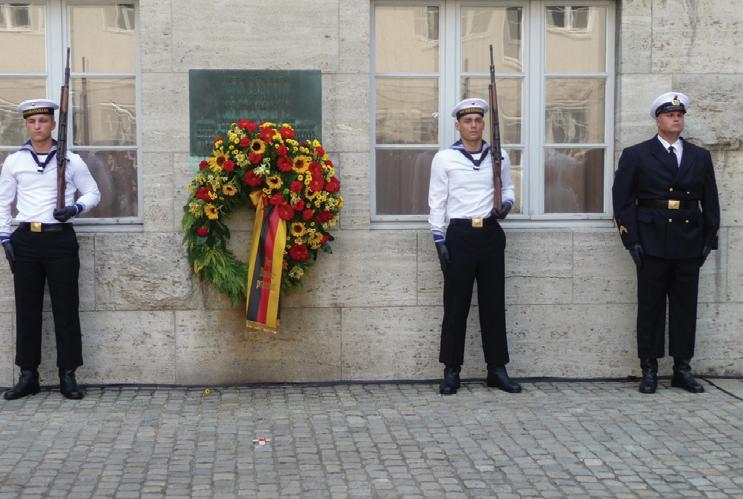
Marines stand guard at the July 20 commemoration
• Johannes Prassek, a Catholic priest in Lubeck, cared for Polish forced labourers and denounced the treatment of workers and prisoners. He was murdered on November 10 1943.
• Sister Maria Restituta, (Helene Kafka), a Franciscan sister who distributed opposition literature and anti-Nazi flyers. The People’s Court sentenced her to death in October 1942 and she was murdered at the Vienna Regional Court on March 30 1943.
I never tire of this historic city and the heroic efforts of so many to free Germany from tyranny. There are more than 25 official sites of remembrance in Berlin, which illustrates a country facing up to its past. So many changes over the years, but it remains a city of hope. Hope for the more than one million Syrian refugees welcomed to Germany. Hope for a progressive government, which has declared Alternative fur Deutschland, (AfD) to be a right-wing extremist party. Such courage inspires us all.
John Hinman Caritas member and parishioner of St Joseph’s, Stokesley
A time of going into a (blossoming) desert to encounter God is how I would describe the latest Tasting the Silence retreat at St Hilda’s Priory, Whitby.
Retreatants came from all kinds of backgrounds, but their common aim was to encounter God in the silence of the present moment, what St Ignatius of Loyola called “finding God in all things”.
Spring is, of course, an ideal time to experience and share in the joy of God in his Creation and the retreatants spend as much time outside as in prayer in the chapel.
Nature is a great and silent teacher of contemplative prayer as we are naturally drawn simply to gaze and to wonder.
Encouraged to use all of their five senses, retreatants spoke with surprise afterwards about their heightened sense of awareness of the presence of God as a reality they had seldom experienced so deeply before. What they experienced on retreat they hope to seek and find on their return to their daily lives.
One said: “I was sitting on West Cliff, so much noise, so many people, and yet beneath it all there was a deep silence and within me a peace that never seemed to end.
“Then I came back to the priory for our next time of meditation and the silence in the chapel was so profound it was almost overwhelming.”
Another person who has been coming to the monthly one-day retreats since the Oasis of Silence programme began in 2023 was surprised just how much time there was
simply to be.
The invitation to spend time outside as well as in the chapel gives an opportunity to assimilate what has just been experienced and to savour it.
“I now know why you often describe the oneday retreat as being, for beginners, like diving off a 10-metre board,” he said.
“It’s quite possible to get to know the Gries Path that way, but in this retreat all the elements are there, spread over four days, giving me so much more time to experience them – and simply enjoy being with God.
“Being able to come back each month for one day will help to keep me more centred – and hopefully allow me to dive back into the serene peace in God that I have experienced now.”
One retreatant who has been practising centring prayer for several years said: “I found what we did here a helpful way to get to the stillness that I long for but that so often seems to evade me. It’s helped me to go deeper than I usually do.”
The Gries Path is a method of contemplative prayer practice taught by the Hungarian Jesuit P Franz Jálics SJ (1929-2022), which leads people through several steps or gateways to become increasingly aware of what is –outside in nature, in their bodies, their breathing, their hands, a sound – as they move ever deeper into the silence of the present moment and the awareness of God’s presence there.
We don’t really use a mantra. We are gently brought to focus our awareness on where we are and how we are – which is, of course, in the silent presence of Jesus Christ. So we’re not saying a mantra but encountering his whole person, human and divine, directly in his name: Jesus Christ.
The next Tasting the Silence retreat at St Hilda’s is from Monday October 20 to Thursday October 23. For more information, contact Sister Helen Stout by emailing hospitality@ohpwhitby.org.uk or calling 01947 899600.
Angela Simek

Cleveland Newman Circle heard a fascinating talk by Terry Doyle on his work with people on the margins of society and the how he helped ensure their voices were heard during the Synodal process.
Terry has a long track record of working with such people at the John Paul Centre in Middlesbrough, helping homeless people develop their independence, taking people from the margins to special retreats at Minsteracres or Ampleforth and building trust through compassionate listening.
It was for this reason Bishop Terry asked him to find a way of involving people from the margins in the Synodal process, drawing upon their insights and experiences.
We listened to pages of quotes Terry had collected containing many difficult messages and heartfelt pleas we all need to hear about how the Church needs to change to serve its people.
We heard about the difficult backgrounds many people come from, high levels of childhood abuse and some of the many reasons people can feel estranged from the Church.
He talked about providing unconditional support where it is needed, rebuilding a person’s inherent sense of dignity and avoiding the tendency to judge people or stigmatise them.
We heard how the young can be especially fired up by matters of social justice and concerns about how we are affecting our climate.
It was encouraging to hear that the messages collected in this process were fed in unvarnished form into the diocesan Synodal committee and found their way into the Middlesbrough diocesan report that was sent forward.
Asked about the risk of the more difficult
messages being diluted as the Synodal process moves forward, he referred us to the document “How to be a Synodal church in mission” (published by the Diocese of Westminster) and expressed the view that the seeds have been planted and will grow. We reflected together on the words of the late Pope Francis, “I see the Church as a field hospital after battle … You have to heal the wounds.”
The metaphor encourages the Church to serve the most vulnerable among us as we navigate these difficult times.
Terry described Pope Francis as a hero of our time who has set the bar high for an inclusive Church.
The talk concluded with a rousing rendition of the gospel hymn I’m Gonna Sit at the Welcome Table.
For further information about the programme of the Cleveland Newman Circle, email

p.egerton123@gmail.com or phone 01642 645732. Talks are held in St Mary’s Cathedral hall, Middlesbrough and all are welcome.
ANDREW CARTER, a parishioner of St Peter’s, Scarborough, continues our series examining the relationship between poetry and prayer… Those of you who were put off Shakespeare at school might wonder what he can teach us about prayer.
He was writing in the wake of the religious turmoil of the Reformation and although the traditional view is that he avoided religious subjects for fear of prosecution, or worse, a careful reading of the plays suggests otherwise.
Why does the Ghost of Hamlet’s father tell his son he has come from purgatory, when belief in purgatory had been banned by the Protestant authorities?
Shakespeare often seems deliberately to trigger memories of the pre-Reformation
world in his audience, and in a poem such as Sonnet 73 he mourns its passing.
Like everyone in London he would have witnessed the martyrdom of Catholics, hung, drawn and quartered for the practice of their faith.
Among these was St Robert Southwell, a young Jesuit missionary and a considerable poet – he may well have been known personally to Shakespeare. He died on the scaffold, after imprisonment and torture, in 1595.
His best-known poem is perhaps The Burning Babe, a startling vision on a snowy night of “a pretty babe all burning bright” who appears in the air and calls the poet to warm his heart at the furnace of his breast.
The child speaks of how “in fiery heats I fry”
for love of the sinful world and the poet remembers it’s Christmas Day!
Shakespeare pays tribute to this tender image some years later when he shows his audience the conscience of his conflicted hero, Macbeth, heatedly generating reasons for not murdering the good King Duncan.
“Pity” he says. “Like a naked newborn babe/Striding the blast, or heaven’s cherubim, horsed/Upon the sightless couriers of the air/Shall blow the horrid deed in every eye/That tears shall drown the wind.”
Those messengers of the air remind us of the God of mercy riding “on the wings of the wind” in Psalm 104 (RNJB translation).
And only Shakespeare could have come up with such a brilliant image of vulnerable love overcoming cruelty as tears drowning the
wind. A lesson for today’s world more than ever.
The theatre of Shakespeare’s time had its distant origins in the Catholic Church’s liturgy and the morality plays of the medieval period.
It was a communal experience, unlike an individual encounter with a poem. There would not have been much time to pause and meditate on the resonance of a single image as you can when reading poetry.
But when we read Shakespeare there is plenty of inspiration for prayer. I recommend especially his last plays, The Winter’s Tale and The Tempest, exploring repentance, reconciliation and forgiveness, “an art/Lawful as eating” one character says, with possibly a hint of the Mass, unlawful at the time.
Patients, doctors, nurses, chaplains, volunteers and faith leaders gathered at the Chapel of the Good Shepherd in Middlesbrough’s James Cook University Hospital to pay tribute to Pope Francis.
The small chapel was full of people wishing to pay their respects as Father Pat Keogh celebrated a Requiem Mass of thanksgiving for the late Pope’s life of service.
A steady stream of visitors over the days of mourning lit candles and prayed for Pope Francis. In his last message to the faithful on the 33rd World Day of Prayer for the Sick in February, Pope Francis, a patient himself being treated for pneumonia, reminded the faithful that physical illness can have an emotional and spiritual impact.
The Holy Father called for a renewed commitment to caring for the sick with love, compassion and faith, recognising that hope is a gift that sustains both those who suffer and those who accompany them.
On April 6, during his own illness, Pope Francis gave a homily for the Jubilee of the sick and healthcare workers, saying God does not wait for our lives to be perfect before he intervenes in them.
“He enters into our wounds. He knocks at our door, not despite our suffering, but because of it.”
He then reflected on his own illness and consequent dependence on others, describing it not as a burden but as a lesson in trust, gratitude and hope.
“Let us not push back”, he said, then added: “Let us allow ourselves to be loved”.
Pope Francis then turned to the healthcare professionals, thanking them for their work and encouraging them to receive every patient as an opportunity to renew their sense of humanity.
“The sickbed can become a holy place, where charity burns away indifference and gratitude nourishes hope,” he said.
Father Pat reminded the congregation of the immense privilege caring for the sick and suffering brings and thanked the chaplaincy team, volunteer chaplains and South Tees staff for their care and vocation to love and serve those who come to the hospital in need of healing and wholeness.
It was part of the “People’s Pope’s” legacy to urge us all to resist the temptation to marginalise and forget those who are elderly, ill or weighed down by the hardships of life.
“Let us not banish suffering from our surroundings,” Pope Francis said. “Let us not exclude those who are frail.”
Instead, we must allow God’s love, poured into our hearts, to transform even suffering into a space of communion and growth.
May Pope Francis intercede for all those who care selflessly for the sick. Amen.
Lisa Maria Opala




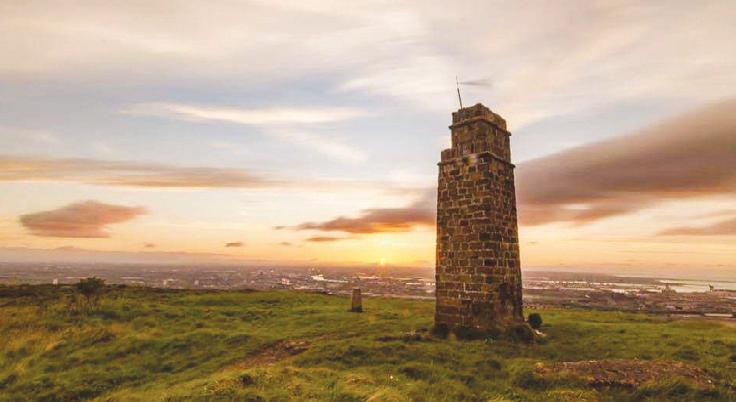
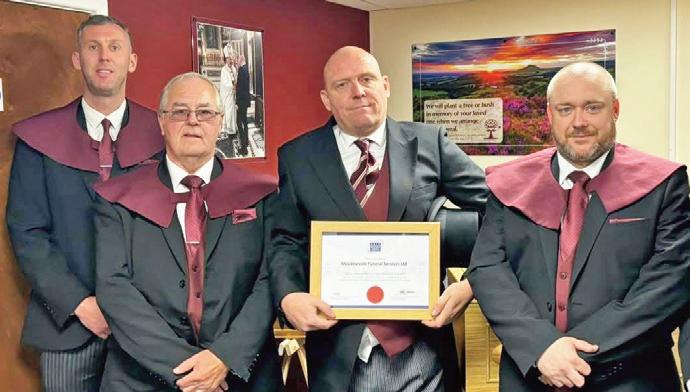
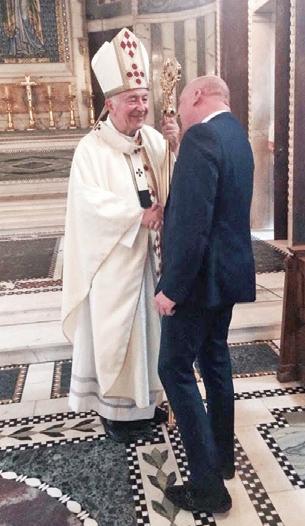



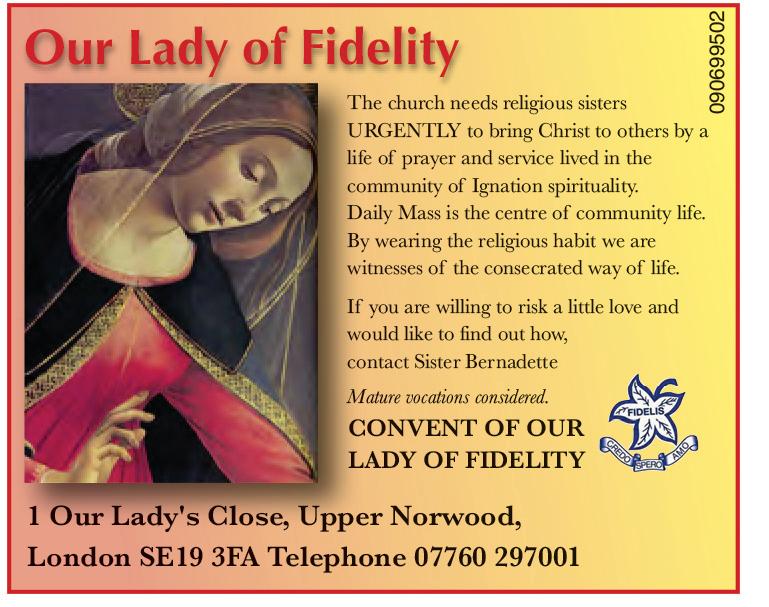




If you would like to advertise
please contact Charlotte Rosbrooke on 01440 730399 or email charlotter@cathcom.org
2 Monday
9.45am-10.25am Beverley Christian Meditation Group meets online. Further information from christianmeditation.beverley@gmail.com. This takes place every Monday.
7pm Catholic charismatic prayer group meets on first Monday each month at St Bede’s Pastoral Centre, Blossom Street, York. For more information, contact Sharon on cdscsmiddlesbrough@gmail.com or 07932 420809.
3 Tuesday
10am Coffee at the Cathedral. Tea, coffee and treats every Tuesday after 9.30am Mass. A warm welcome and friendly atmosphere. Make new friends and enjoy some fellowship. Those who are alone especially welcome.
10am Christian Meditation Group meets online. Further information from Terry Doyle terry-doyle@live.co.uk. This takes place every Tuesday.
4 Wednesday
5.30pm Sung Evening Prayer and Benediction at St Mary’s Cathedral. Join us every Wednesday at 5:30pm for a time of prayer and quiet reflection before the Blessed Sacrament.
6 Friday Events, articles and photographs for the July edition of the Voice are due by this day.
7 Saturday
10am-4pm Visit of the Pilgrim Statues of our Lady of Fatima to St Mary’s Cathedral. 11am Catholic women are invited to share an hour of feminine communion including meditation, via Zoom. Text Barbara on 07796 117704 with your mobile number and email address so she can add you to the WhatsApp group, or email catholicwomenmdl@gmail.com for Zoom link.
Copy and photographs for inclusion in the Catholic Voice
should be sent to: The Editor, Middlesbrough Diocesan Catholic Voice, Curial Offices, 50a The Avenue, Linthorpe, Middlesbrough, TS5 6QT. Tel (01642) 850505, email catholicvoice@rcdmidd.org.uk
Deadline Friday June 6 for July edition.
Where possible please send articles in Word and photographs as jpegs. Please confirm when you send in your photographs that those who appear in them have given their permission for publication.
6pm Mass in Italian in the Father Kelly Room, Our Lady, Acomb, York. Followed by refreshments. All welcome.
8 Sunday
10am Visit of the Pilgrim Statues of Our Lady of Fatima continues at St Mary’s Cathedral. 3pm Mass for LGBT+ community, family and friends at the Chapel of the Bar Convent. Doors open from 2.30pm.
9 Monday
2pm Music for the Mind, an hour of fun and music for people living with dementia, their friends and carers, with Trish McLean. All welcome. St Mary's Cathedral is a dementiafriendly venue.
10 Tuesday
12.45pm Catholic Women's Luncheon Club meets at the Kingston Theatre Hotel, Kingston Square, Hull. Lunch at 1pm. All ladies in the Hull and East Riding area welcome. Call 01482 446565 or email jayne.wilson24@ymail.com.
7pm Mass for Knights of St Columba Council 29 at St Mary’s Cathedral, followed by a meeting.
11 Wednesday
7pm Hull Circle of the Catenian Association’s monthly meeting at Lazaat Hotel, Cottingham,
followed by a buffet-style meal. Email Charles Cseh at hullcirclesecretary@gmail.com.
15 Sunday
3pm Catholic Fellowship Mass at St Alphonsus in North Ormesby, Middlesbrough, with Father John Idio.
20 Friday
7.30pm Seventh Avenue Arts presents Simon and Garfunkel Through the Years at St Mary’s Cathedral, Middlesbrough. Tickets from ticketsource.co.uk/middlesbroughcathedral.
21 Saturday
Noon Mass with Bishop Terry to celebrate the 70th anniversary of Canon Pat Harney’s priestly ordination at English Martyrs, York. All welcome.
7.30pm Irish dance with Pat Jordan at the Erimus Club, Cumberland Road, Middlesbrough TS5 6JB. Contact John Brown on 07871 958412.
28 Saturday
Noon, LGBT+ social gathering at the Bar Convent, York. All welcome.
If you have any events that you would like to include in the Out and About section, please email heidi.cummins@rcdmidd.org.uk
English Martyrs’ parishioner Fred Ring has been awarded Membership of the Order of the British Empire (MBE) for services to the community in York.
The honour was conferred at Buckingham Palace by the Princess Royal, Princess Anne. Fred pioneered the York Racial Equality Network (YREN), a charity founded in 1992 by people from the diverse communities of York.
It aims to help York become a more inclusive city by challenging race discrimination and promoting equality of opportunity between different groups.
Fred has been a cantor at Saturday evening Mass for nearly 40 years. He says it’s a privilege, a joy and a blessing to lead the congregation weekly in prayerful song.

The work of the Poor Servants of the Mother of God in the Archdiocese of Liverpool will come under the spotlight at this year’s York Catholic History Day.
Paul Shaw, the congregation’s archivist, will give an illustrated overview of the sisters’ work, including nursing, social work and care of children and the disabled.
The religious community was founded by the Venerable Mother Magdalen Taylor in 1872. Ten years later, they began their work in the Archdiocese of Liverpool and remain there today.
Francis Joseph Sloane, the grateful alumnus of Lucia Luck’s talk, died the year before the foundation of the Poor Servants, in 1871. He was born in 1794 and educated at Ushaw College, the former school and seminary near Durham. Later he moved to Florence, where he made his fortune as the owner of a copper mine.
He gave generously to various projects in
Florence, including the new façade for the Church of Santa Croce, but was also a generous donor to his old school. Lucia has drawn extensively on correspondence between Sloane and members of the college covering the years 1815-63 to research the biography of this generous former student.
Daniel Reed’s talk, “Jaques Sterne and the Bar Convent revisited – persecutor turned protector?” will take us back to the mid-18th century when Jaques Sterne was precentor of York Minster from 1742 until his death in 1759.
The campaign of persecution against the Bar Convent which he initiated represented the worst excesses of anti-Catholic agitation in the city at that time and makes his about-turn to a position of amiability to the community a few years later seem all the more inexplicable.
Daniel Reed has used previously unexplored sources at the Bar Convent and elsewhere to re-examine this period in the convent’s history
and place it in the broader context of politicoreligious conditions in the Diocese of York at that time.
The concluding paper, “The Mary Ward Family becomes one: CJ and IBVM unite”, will bring the story of the Bar Convent up to date. For historical reasons, the foundation of Mary Ward’s Institute in Ireland early in the 19th century could not be directly dependent on York and subsequently evolved as a canonically separate entity. Now, in November, the two will merge. Sister Patricia Harriss will give a brief explanation.
This will be followed by an open forum when participants can speak briefly about work in progress, provide information about forthcoming events and publications that may interest the audience, ask for information relating to current research and make suggestions for future events.
This year’s York Catholic History Day takes place at the Bar Convent on Saturday June 14
– please note the change of date. As usual, the talks will cover a range of topics, over several centuries.
The programme begins at 10.30am, with registration and tea and coffee at the Bar Convent.
Lunch is available at the Bar Convent café (please phone 01904 464910 to book a table). At lunchtime there will be an opportunity to visit the Living Heritage Centre, where the recently rediscovered Arma Christi medieval scroll is now on display in the new Treasures Gallery.
Special Collections Manager Hannah Thomas will provide a brief introduction to the scroll –see the website for full details including ticket prices. The day will end with Mass in the chapel at about 4.30pm
The cost of the day is £20, students £10 (cash only please). For more details please contact judith.smeaton@btinternet.com.
Thirty young people from Hull travelled to meet up with some of their friends from Scarborough for the Faith Youth Day at St Edward’s.
After the initial excitement of reuniting with friends, the day began with a beautiful talk by Father William Massie based on the encyclical letter Dilexit nos – The Human and Divine Love of The Heart of Jesus.
The talk began with the eternal truth that we all want to love and be loved but that it is “Love himself” – that is, Jesus Christ – who loves us like no one else can.
We see examples of this through his concrete actions in scripture and how we respond through the witness of the saints, especially in St Thérèse of Lisieux’s response in her letter to her sister, Lẻonie: “Perfection is very easy to practise because I have understood it is a matter of taking hold of Jesus by his heart.”
The talk concluded by explaining that Jesus wants to come into our hearts and invites us to take him “by his heart”.
After the talk everyone brought their hearts to Jesus in confession and took Jesus “by his
heart” as they received him in Holy Communion at Mass.
After lunch we went down to the beach for games, sports and even a spot of sandcastle building and everyone’s heart got a good workout on the steep walk back up to the parish hall to hear the testimony of two students from the Catholic Chaplaincy on their conversion to the Catholic faith.
The young people had lots of profound questions for them and were intrigued to hear the difference the faith had made to them.

The day ended adoring Jesus in the Blessed Sacrament before we all headed home. We’re all looking forward to meeting up again for Summertime at Ampleforth, where all the fun, faith and friendship we had on this day will be extended over a four-day stay in the beautiful surroundings of Ampleforth Abbey. If you are or know a young person aged 10 to 16 who might like to share in this experience, email northernsummertime@gmail.com. Michelle Robertson
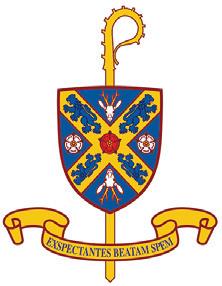
Could you help us inspect parish financial records?
Do you have some financial know-how and a little time on your hands?
Would you be willing to join our friendly team of volunteer inspectors who each visit two-to-three parishes each year to examine their financial and Gift Aid records?
This is important and challenging work but it also enjoyable and rewarding.
If you are interested and would like to discuss the role in more detail, please contact the financial secretary on 01642 850505 or email financialsecretary@rcdmidd.org.uk.
Bishop Terry has announced the following clergy moves, which will take place by the weekend of August 16 and 17.
Father Tom O'Neill will step down from pastoral duties, with Father Bill Serplus becoming parish priest of the Holy Name of Mary, Middlesbrough.
Father William Massie will become parish priest of St Aelred’s, York, with Father Philip Cunnah becoming parish priest of Our Lady of Lourdes & St Peter Chanel, Hull, and chaplain to Hull University.
He will also be parish administrator of St Vincent’s, Hull, where he will be assisted by Father Richard Nwagwu
Father Paul Dowling will assist Father Albert Schembri in Bridlington, Filey and Eastfield, and will live at Filey.
Father Peter Taylor will become parish priest of Blessed Nicholas Postgate Parish of Redcar and Marske and parish administrator of St Paulinus, Guisborough. Father Philip Osuagwu and Father Ferdinand Obianyo will assist Father Peter in both parishes.
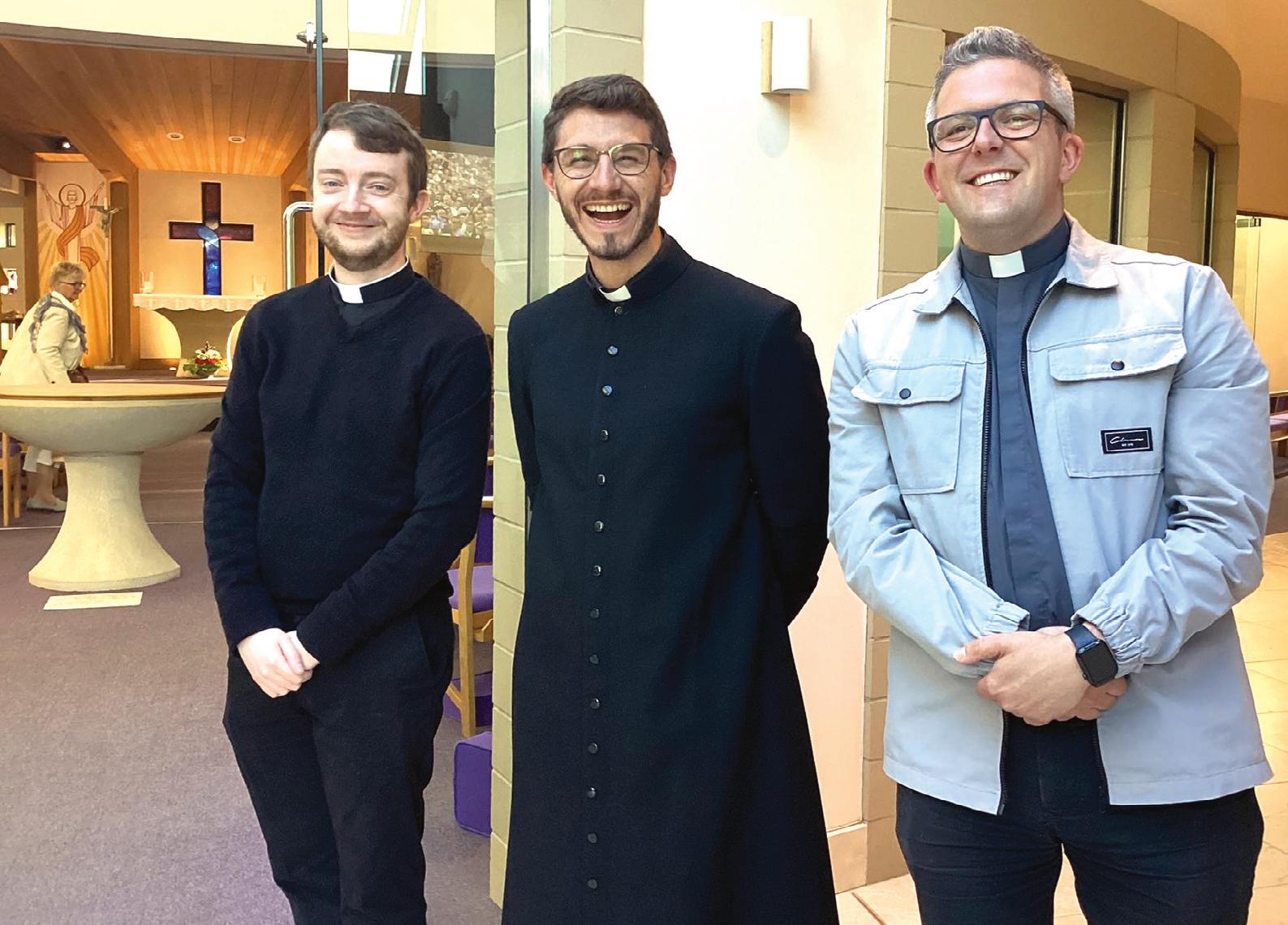
Five acres of paradise will be open to the public once again this month to raise funds for a worthwhile cause.
Tudor Croft Gardens, Guisborough, will open on Saturday June 7 and Sunday June 8 from 11am to 4pm in aid of Kids Kabin.
Owner Mike Heagney said: “Kids Kabin does amazing work with disadvantaged young people in Middlesbrough, so we hope the sun shines and people come out in numbers for this hugely enjoyable weekend.”
The stunning gardens will be in full bloom and as usual you can enjoy homemade
afternoon teas along with prosecco on the lawns and special plants will be for sale. Entertainment will come from the Lavender Mob on both days with the Dalesman Singers also in concert on Saturday and Teesside Wind Band on Sunday.
Free, off-road parking will be signposted and well supervised. Admission is £10, children free. There’s no need to book, just turn up on the day and pay by cash or card
For regular updates from Tudor Croft, follow Facebook.com/TudorCroftGardens.

Look how someone created this with stones at Flamborough cliffs. Can you spot the little bird they formed?
God gives us all gifts – sometimes we don’t even realise we have them. Search inside your soul and recognise that God has given you so many talents with which help others.
The St Vincent de Paul Society is waiting for you to contact us and let us know what you can do to help others around you in need. Can you pop and listen to someone who has wonderful stories to tell but nobody visits them?
Is there an SVP shop near you that could do with a helping hand, or a food bank? Perhaps you would be interested in supporting the Mini Vinnies in a school? Could you be involved in prison visiting or helping refugees?
I suspect many of you can bake some nice cakes for fundraising or sing in a choir at Xmas.
What talents do you have? Contact me to have a chat and let me know what you would like to share. What do you get in return? Training, support and, best of all, you become
one of the Vincentian family. All we ask is an hour a week or whatever you can spare. “Among us, who is above must be in the service of the others. This doesn’t mean we have to wash each other’s feet every day, but we must help one another.” Pope Francis, RIP Please email me at teresao@svp.org.uk or call 07554 336984.
Teresa O’Hagan SVP Membership Support Officer
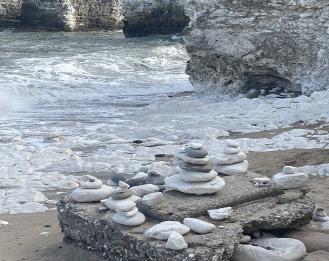
This month, as the Church prepares for life under our new Holy Father, it seems good to also give thanks for the extraordinary life, teaching and example Pope Francis shared with the world.
The Laudato Si’ movement is a response to the seeds Pope Francis planted – seeds of tenderness, justice and care for our common home.
His voice awakened millions, and his call to ecological conversion continues to echo across the earth.
Every plan created, every action taken, every small step toward healing the planet is part of the living legacy he leaves behind. We are all part of that story. We are all part of his impact.
His death has also had an invigorating effect, because it is now up to all of us to
continue that legacy with renewed energy during this year of Jubilee and beyond.
I would like to quote from one message of thanks on the Laudato Si’ Action Platform: Gracias, Papa Francisco.
You taught us that the smallest gestures could hold the greatest love.
You reminded us that faith is not just proclaimed—it is lived, often in silence, with trembling hands, with open hearts. Your legacy is not one idea. It is a thousand seeds.
Let us now say what so many have said in prayer:
You gave us a Church with eyes wide open.
You reminded us that ‘everything is connected’. You showed us that to care for creation is to
care for Christ.
You gave us the courage to act.
You asked us to dream.
And when you left us, you did so gently, with your last blessing, your last walk among us. Now, we walk on.
Guided by your love. Humbled by your example.
And held in your legacy.
Barbara Hungin

Catholic charity HCPT (Hosanna House and Children's Pilgrimage Trust) is celebrating its latest Easter pilgrimage to Lourdes, its first with liturgies provided by volunteers from the North-East.
At the biggest Mass of the pilgrimage, in the Underground Basilica, Bishop of the Forces Paul Mason defined the assembled pilgrims as angels.
Amid references to the Angel of the North, and his hometown football club Newcastle United, Bishop Paul said there were three important aspects to being an angel.
“We use our wings to bring the message of good news, our halo to bring light into each other’s lives, and we are made of feathers because we work and move with a lightness of being,” he said.
The death of Pope Francis marked a poignant beginning to the pilgrimage on the Monday. Church bells tolled in the shrine and mourners travelled to Lourdes to pay their respects.
HCPT’s liturgies and events marked the sad loss and also provided a lively expression of worship for the children and young people present, with the pilgrimage theme of “Angels Among Us”.
Knitters from across the country created colourful knitted angels to give to every child on the pilgrimage.
A total of 1,300 UK pilgrims took part, organised into 67 volunteer-run pilgrimage groups, including HCPT Group 122 – York. A large international element was present, with further groups travelling from Belgium, Croatia, Ireland, Italy, Poland, Romania, Switzerland, USA and the West Indies.
The overwhelming focus of the annual pilgrimage was the children. Hundreds of children and young people, aged eight and over, with a variety of needs, enjoyed a lifechanging week away. They were supported by an army of volunteer helpers, priests and
nurses, many of them under 30 years old. Conditions experienced by the children taking part included learning difficulties, behavioural problems and autism. Other common conditions included asthma, Down’s Syndrome and epilepsy.
Besides Bishop Paul Mason, also travelling on the pilgrimage were Archbishop Leo Cushley (St Andrews and Edinburgh), Archbishop Manuel Cruz (Newark, USA), Bishop Jim Curry (Westminster), Bishop Frank Dougan (Galloway), Bishop Donal McKeown (Derry, Ireland) and Bishop Joseph Toal (Motherwell).
Pilgrims each wore colours unique to their group and were prominent within the shrine area and at other sites around the town connected to St Bernadette.
HCPT swelled the torchlight procession on the Tuesday evening and the Blessed Sacrament procession on the Thursday, carrying colourful banners.
There were also opportunities in the week for arts and crafts, singing, parties and fancy dress.
The pilgrimage is a major undertaking for all concerned. All volunteer helpers are trained and vetted to support the children and young people and to keep them safe. To transport the UK contingent to Lourdes and back, HCPT chartered six flights each way from local airports. Groups stayed in 31 hotels in the busy centre of Lourdes.
The pilgrimage was preceded on Good Friday by HCPT’s sponsored cycle from Versailles to Lourdes. A team of cyclists travelled 550 miles to join the pilgrimage, raising over £40,000 so far – justgiving.com/campaign/hcptcycle25.
Thousands watched Thursday’s Mass live on the internet. A group from Nicholas Breakspear School in St Albans recorded video interviews between its students and pilgrims on HCPT’s social media.
HCPT’s pilgrimage season continues from May

We hope to hear more from HCPT Group 122 – York in next month’s paper
to October at its Hosanna House facility. The fully accessible house, in the hills above Lourdes, will host more than 1,000 pilgrims of all ages, many of them with disabilities or life-
limiting conditions. Then in 2026 HCPT will celebrate its 70th anniversary with its biggest Easter pilgrimage to Lourdes for some time.
Middlesbrough Catenians Circle president
Chris Rhodes visited the town’s Trinity Catholic College to present two cheques to support this month’s Pilgrimage to Lourdes.
The first cheque was handed over to Trinity lay chaplain Liz Sanders to help pupils taking part, and the second was given to pilgrimage director Mark Taylor for the Lourdes Sick Fund.
Chris said one of the Catenian Association’s aims is to advance the interests and development of young Catholics and assist them in their choice or pursuit of a career.
Liz said the money would be put to good use and praised the Catenians for their generosity.
She said: “Their continued support, prayers and encouragement mean so much, helping both our young people and the sick of our community take part in this life-changing pilgrimage.
“A heartfelt thank you to the Catenians for their generosity and belief in the power of this journey.”

Congratulations to Holy Name of Mary parishioner Judith Brown, who has been presented with the British Empire Medal for her
Judith,
She
Our picture shows Judith’s son-in-law Sean, son Greg, High Sheriff of North Yorkshire Dr Ruth Smith, LordLieutenant of North Yorkshire Jo Ropner, Judith and her daughters Jenny and Madeleine.





